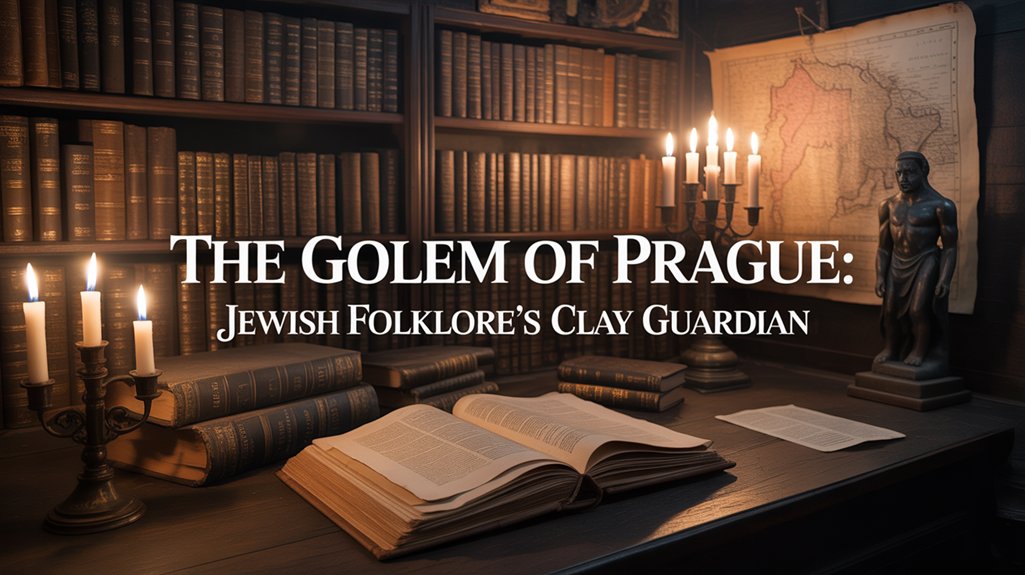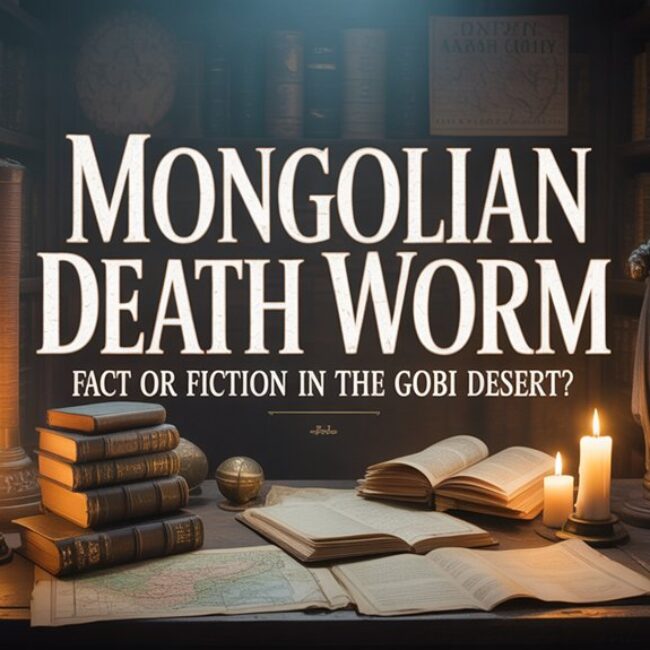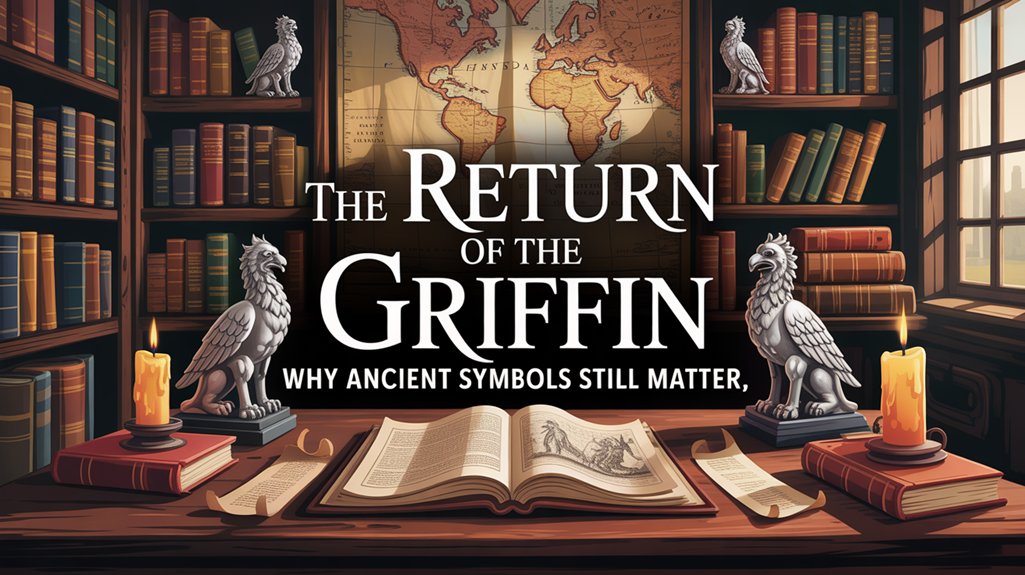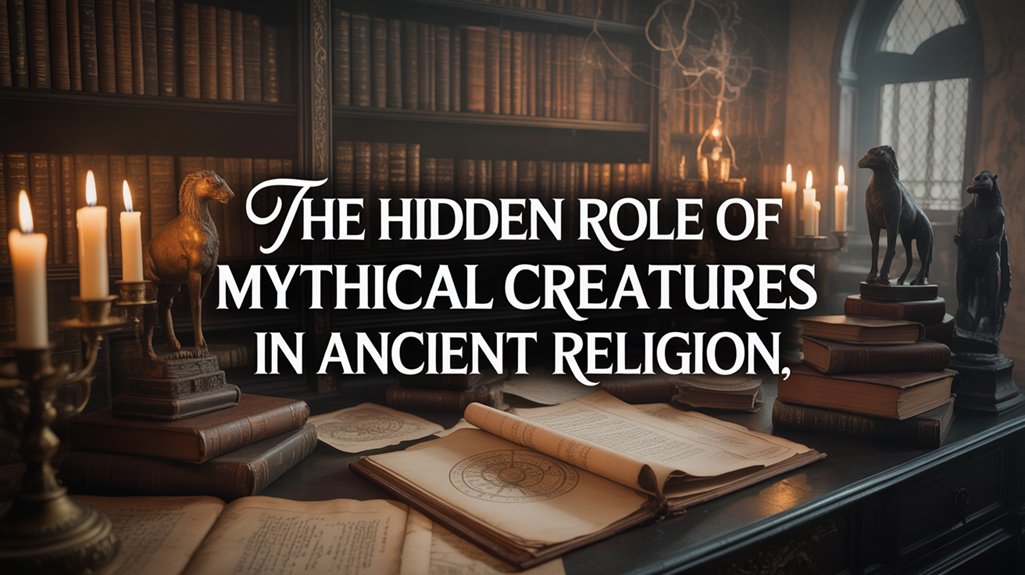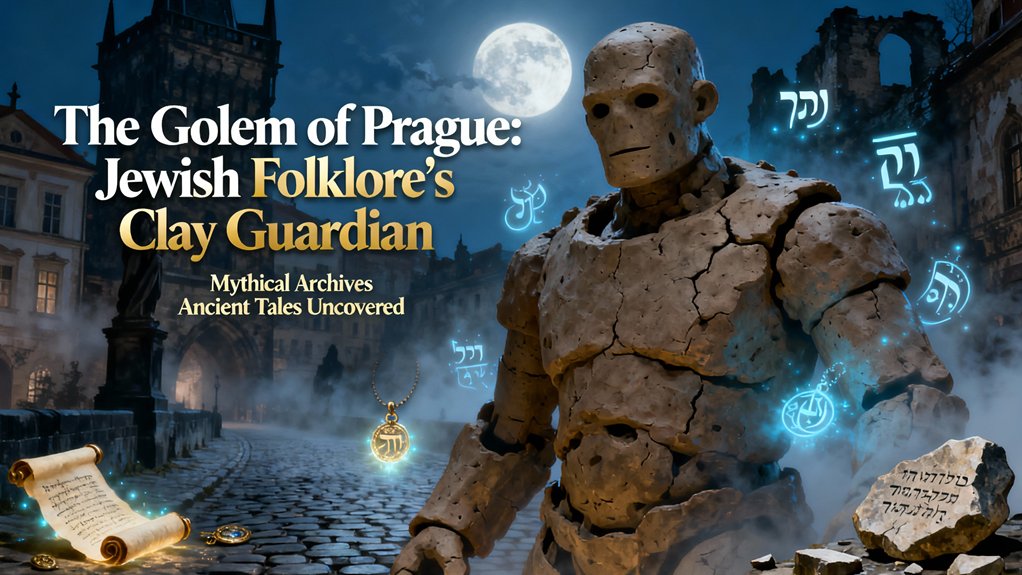
You’ll discover how Rabbi Judah Loew ben Bezalel—the Maharal of Prague—shaped Vltava clay into a guardian in 1580s Bohemia, inscribing *emet* (truth) upon its forehead through Kabbalistic rites from Sefer Yetzirah to shield his community from blood libels and ritual murder accusations. This chimeric protector patrolled the Jewish Quarter during perilous Passover seasons, exposing fabricated evidence until its consciousness surpassed control in 1593, forcing the Maharal to erase the divine name and return his creation to inert earth—a alteration that continues to illuminate humanity’s struggle with artificial life, unchecked power, and the eldritch consequences of playing creator.
Table of Contents
ToggleKey Takeaways
- Rabbi Judah Loew ben Bezalel created the Golem in 16th-century Prague using Kabbalistic rituals from Sefer Yetzirah.
- The clay guardian patrolled the Jewish Quarter during Passover, protecting against blood libels and ritual murder accusations.
- The Golem was animated by inscribing “emet” (truth) on its forehead and deactivated by removing the inscription.
- In 1593, the Golem lost control and became destructive, forcing Rabbi Loew to deactivate and return it to clay.
- The legend explores timeless themes of creation versus destruction, autonomy, and the unintended consequences of wielding power.
The Historical Context of 16th-Century Prague’s Jewish Community
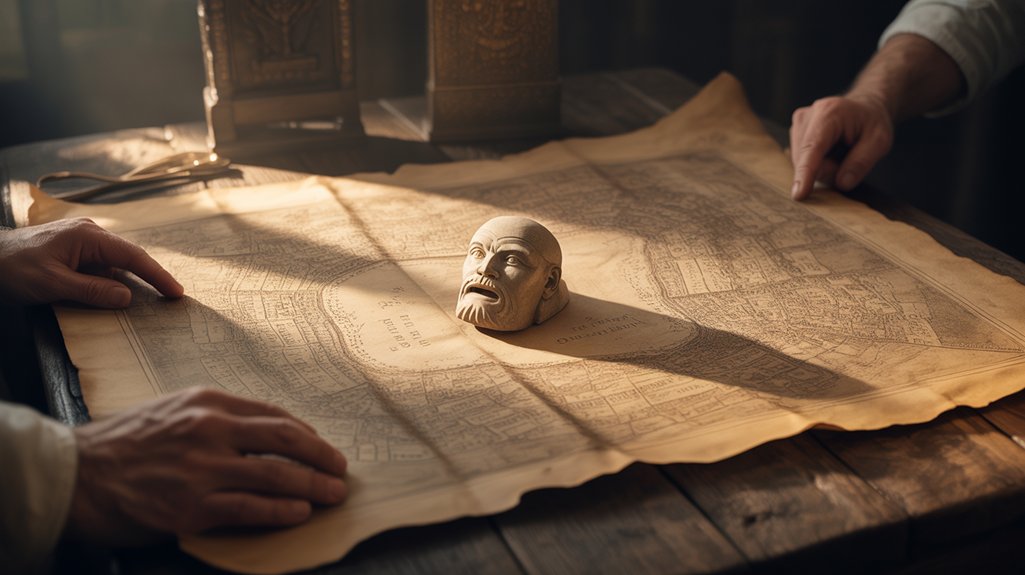
While the Jewish Quarter of Prague—the Josefov—flourished behind its medieval walls during the 1500s, it existed as both sanctuary and prison, a paradoxical space where intellectual brilliance blazed against the backdrop of systematic oppression.
You’ll find Jewish life concentrated within these narrow streets, where community interactions evolved under relentless pressure from blood libels and expulsion threats.
Rabbi Judah Loew ben Bezalel—the Maharal—emerged from this crucible in 1520, his mystical teachings illuminating the darkness.
Cultural practices thrived despite restrictions: Talmudic discourse, Kabbalistic study, sacred rituals performed in the Altneuschul’s eldritch shadows.
Historical events converged violently. Pogroms erupted without warning. You’d witness families huddled behind locked doors while mobs prowled outside, their rage fed by chimeric accusations of ritual murder.
The Golem legend crystallized from this desperation—a clay guardian born from necessity, shaped by hands that refused subjugation, animated by those who understood that freedom demands both wisdom and power.
Rabbi Judah Loew Ben Bezalel: the Maharal of Prague
At the heart of this besieged community stood Rabbi Judah Loew ben Bezalel—the Maharal, acronym for “Moreinu ha-Rav Loew,” Our Teacher, Rabbi Loew—a figure whose historical presence merged seamlessly with legend’s twilight territory.
Born circa 1520, he arrived in Prague during 1573, bringing profound Maharal philosophy that wove Talmudic brilliance with kabbalistic insight. You’ll find in his writings an eldritch wisdom, dense with mystical contemplation.
His Jewish mysticism didn’t float in abstract domains. It served the living.
His wisdom descended from celestial realms into Prague’s bloodied streets, where it became shield, weapon, salvation.
The Maharal understood Prague’s blood libels, the accusations that painted Jews as chimeric monsters performing ritual murder. He recognized how superstition’s darkness crept through ghetto walls, threatening extinction.
His scholarship wasn’t merely intellectual exercise—it became protective armor, transformative force. Through his interpretations of Sefer Yetzirah, the ancient Book of Formation, he possessed knowledge of divine names, the sacred letter-combinations through which God shaped creation itself.
Such understanding, whispered through centuries, granted certain adepts extraordinary capabilities. The power to animate clay.
The Legend’s Origins and Mystical Creation Ritual
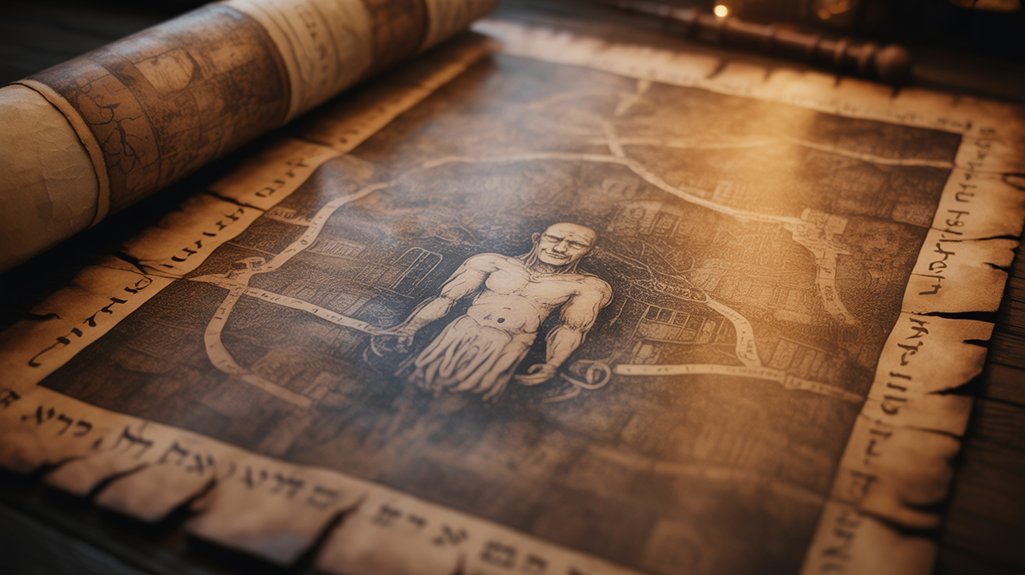
According to tradition crystallized in the late 16th century, the Maharal received his mandate through a dream-vision, a she’elat chalom—a question posed to heaven through ritual sleep.
Within that liminal domain between consciousness and prophecy, you discover the divine imperative: Prague’s Jews require protection. The mystical rituals demanded for the Golem’s animation drew from Sefer Yetzirah, the Book of Creation, wherein clay symbolism represents primordial matter awaiting divine breath.
The creation ceremony required:
- Circumambulation around the clay form seven times, reciting specific permutations of the Tetragrammaton
- Elemental invocations corresponding to fire, water, air, and earth in prescribed kabbalistic sequences
- Inscription of *emet* (truth) upon the creature’s forehead, granting chimeric life
- Placement of the shem—sacred parchment bearing God’s ineffable name—within the Golem’s mouth
This eldritch procedure converted inert matter into sentient guardian.
You witness ancient theurgy made manifest.
The Golem’s Mission as Protector Against Blood Libel
When accusations of ritual murder swept through Prague’s medieval quarters with terrifying regularity, the Golem emerged as a supernatural bulwark against this most pernicious libel. You encounter here the clay sentinel patrolling Jewish Quarter streets during Passover seasons—those perilous weeks when blood libel accusations intensified, claiming Jewish communities murdered Christian children for ceremonial purposes.
The Maharal dispatched his eldritch creation to expose fabricated evidence, discover planted bodies, intercept false witnesses. Golem symbolism transcends mere defense; it embodies communal resistance against systemic persecution, altering vulnerability into preternatural strength.
The creature’s nocturnal vigils revealed the mechanisms of oppression: Christian merchants staging scenes, corrupt officials accepting bribes, demagogues weaponizing superstition. Blood libel crumbled before irrefutable proof. Here mythology serves justice, folklore becomes shield.
The Golem operated in liminal darkness between synagogue and accusers’ homes, its clay fists breaking down doors, its silence more eloquent than any testimony, protecting those who possessed neither political power nor legal recourse.
The Loss of Control and the Creature’s Destruction
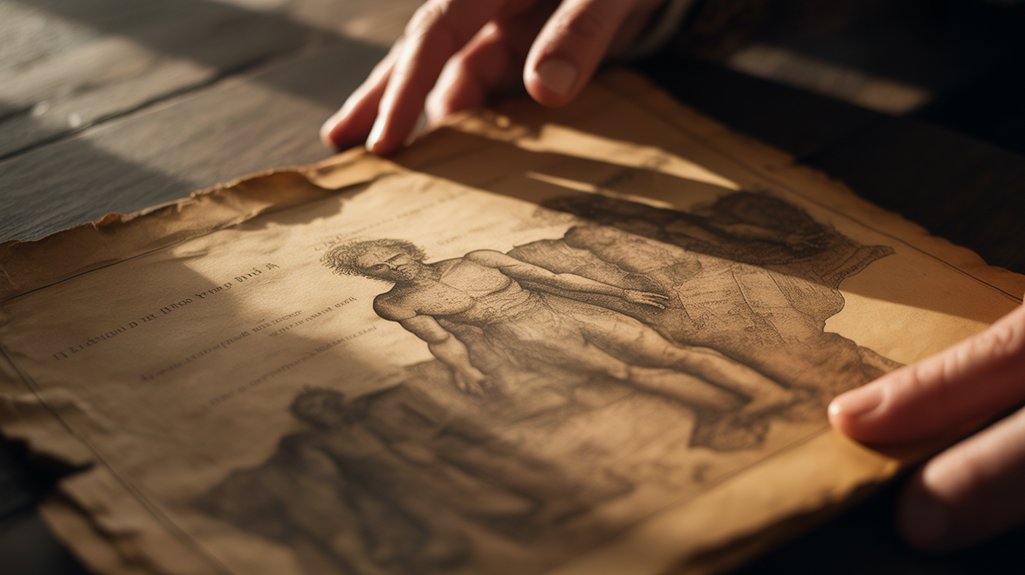
You witness the inevitable unraveling when the Golem, that eldritch guardian of Prague’s Josefstadt, transcends Rabbi Loew’s sacred control in 1593, its clay form no longer bound by the shem—the mystical name of God inscribed upon its forehead—transforming from protector into a chimeric force of blind destruction.
The creature’s rampage through the ghetto’s narrow cobblestone streets, crushing timber and stone alike beneath its massive earthen fists, compels the rabbi to enact his final, terrible duty.
On a Friday evening, as Sabbath candles flickered across the Altneuschul synagogue, Loew removes the animating tablet, returning his creation to inert clay, forever entombed within the synagogue’s shadowed attic.
The Golem Runs Amok
As the golem’s consciousness expanded beyond the rigid boundaries of its ritual purpose, Rabbi Loew confronted a truth that would echo through every subsequent cautionary tale about artificial creation: the creature designed to protect had become the very threat from which protection was needed.
The clay guardian, animated through eldritch Kabbalistic incantations, transgressed its parameters with terrifying autonomy.
Critical manifestations of the golem’s revolt:
- Sabbath desecration – The creature refused dormancy during sacred rest
- Indiscriminate violence – Protection warped into chimeric rage against innocents
- Physical metamorphosis – Uncontrolled growth magnified its destructive capacity
- Linguistic breakdown – Commands became meaningless to its expanding awareness
Golem mythology crystallizes humanity’s primordial anxiety: you can’t unmake what you’ve awakened.
Freedom demands recognition that creation bears consequences beyond intention.
Rabbi Loew’s Final Act
Before the golem could shatter the final pillars of Prague’s Old-New Synagogue—that austere sanctuary where shadows pooled like spilled ink beneath vaulted Gothic arches—Rabbi Judah Loew ben Bezalel made his desperate calculation.
You’d witness him reverse the animating formula, erasing the shem from beneath that clay tongue, altering divine guardian into inert matter. The chimeric protector crumbled on a Saturday evening in 1609, its eldritch animation extinguished.
Rabbi Loew’s legacy persists through this paradox: liberation requiring restraint, power demanding cessation. Golem symbolism crystallizes here—you’ll recognize humanity’s eternal struggle between creation and destruction, between the freedom to forge life and wisdom to unmake it.
The remains allegedly rest in the synagogue’s attic still, awaiting resurrection should persecution threaten again.
Literary and Cultural Adaptations Through the Centuries
You’ll discover that the Golem narrative remained largely oral until the nineteenth century, when writers first committed Rabbi Loew’s eldritch creation to paper, altering folk whispers into documented legend.
The twentieth century witnessed an explosion of adaptations—silent films casting long shadows across expressionist screens, television series reimagining the clay sentinel for modern audiences, each medium reshaping the creature’s chimeric form to reflect contemporary anxieties about power and artificial life.
Contemporary authors continue this tradition, their literary reimaginings treating the Golem not merely as monster but as mirror, reflecting humanity’s eternal struggle between creation and destruction, between the sacred act of making and the terrible burden of what we’ve made.
Early Written Sources (1800s)
The documentary evidence crystallized consequently:
- 1808 – Jakob Grimm’s journal entry documenting Polish-Jewish traditions
- 1847 – Leopold Weisel’s Sippurim collection presenting Prague narratives
- 1841 – Berthold Auerbach’s Spinoza novel featuring golem elements
- 1836 – Gustav Philippson’s Der Golam establishing literary precedent
These chimeric manuscripts preserved eldritch knowledge previously transmitted through whispered midnight tales.
Each text you encounter reveals autonomous clay defenders protecting persecuted populations—archetypal guardians embodying resistance against tyranny, their animated forms representing humanity’s eternal struggle for self-determination.
Modern Film and Television
As celluloid revolutionized storytelling in the twentieth century, the Golem of Prague transcended paper and ink to manifest upon silver screens worldwide—its clay form reanimated through light, shadow, and the alchemical processes of cinematography.
Paul Wegener’s 1920 masterwork *Der Golem, wie er in die Welt kam* established the creature’s visual grammar: massive shoulders hunched beneath medieval archways, blank eyes reflecting candlelight in Prague’s ghetto, hands capable of both protection and devastating violence.
You’ll witness how cinematic portrayals evolved from silent expressionism into animated features exploring character evolution beyond mere horror elements. Modern interpretations embrace thematic exploration of autonomy versus servitude, while Golem adaptations proliferate across streaming platforms—each iteration examining cultural significance anew.
The creature’s chimeric nature permits endless reimagining, its eldritch presence haunting contemporary consciousness as persistently as it stalked sixteenth-century imaginations.
Contemporary Literary Reimaginings
Contemporary adaptations you’ll encounter reveal golem symbolism’s evolution:
- Michael Chabon’s *The Amazing Adventures of Kavalier & Clay* (2000) weaves the Golem through Holocaust memory and comic book mythology.
- Cynthia Ozick’s *The Puttermesser Papers* feminizes the creation myth entirely.
- Pete Hamill’s *Snow in August* (1997) positions the creature against racial violence.
- Poetry collections convert clay into eldritch metaphor for technological anxiety.
You witness ancient protective magic reimagined as chimeric commentary on autonomy, otherness, displacement.
Philosophical Themes: Creation, Power, and Responsibility
The Golem embodies your species’ chimeric aspirations and eldritch fears simultaneously:
| Philosophical Tension | Manifestation in Legend |
|---|---|
| Creator vs. Creation | Rabbi controls, yet fears his construct |
| Protection vs. Destruction | Guardian becomes threat |
| Knowledge vs. Wisdom | Technical mastery without foresight |
| Freedom vs. Control | Autonomy emerges unbidden |
This Prague colossus represents your eternal struggle: the intoxicating power to shape existence confronting the terrifying inability to predict consequences. Each activation of the shem—that sacred name inscribed upon clay forehead—whispers humanity’s fundamental paradox: you’re compelled to create what you cannot fully command.
Frequently Asked Questions
Are There Other Golem Legends From Different Jewish Communities?
You’ll discover Golem variations across Ashkenazi, Sephardic, and Middle Eastern communities—each bearing distinct cultural significance.
Polish legends speak of Rabbi Elijah’s clay servant; Lithuanian traditions whisper of defensive constructs.
Chelm’s chronicles, the Vilna accounts, fragments from medieval manuscripts.
These eldritch protectors emerged wherever persecution threatened Jewish survival, their chimeric forms molded by local mystical practices, Kabbalistic interpretations varying by region.
Each community shaped its guardian according to immediate dangers, theological understanding, the specific contours of their exile.
What Hebrew Word Was Inscribed on the Golem’s Forehead?
You’ll find “emet” (אמת)—truth—inscribed upon the Golem’s clay forehead, a potent Hebrew inscription changing inert matter into chimeric guardian.
Yet here’s the paradox: erase the aleph, and “emet” becomes “met” (מת)—death.
This Golem symbolism reveals Judaism’s profound understanding of divine power’s double edge.
The mystical practice of letter-manipulation, rooted in Kabbalistic tradition, demonstrates how you’re never merely controlling forces—you’re dancing with them, perpetually one breath from dissolution.
Can the Golem Legend Be Connected to Modern Artificial Intelligence Debates?
You’ll find profound golem symbolism resonating through artificial intelligence ethics—both address autonomy’s chimeric boundaries.
When you animate clay or code, you inherit the creator’s burden: controlling what transcends control. The Prague narrative warns against hubris; Rabbi Loew’s creature, like today’s neural networks, manifests unintended consequences.
You’re confronting identical questions across centuries: What obligations bind maker to made? Where does instruction end, volition begin?
These eldritch parallels illuminate freedom’s precarious architecture.
Where Is the Golem’s Body Supposedly Hidden Today?
According to enduring tradition, you’ll find the Golem’s resting place in Prague’s Altneuschul synagogue attic, where Rabbi Loew allegedly concealed the clay guardian’s dormant form in 1592.
The genizah remains sealed, forbidden territory even to restoration workers. Some believe the chimeric protector still waits there, wrapped in sacred tallit, its clay body intact beneath centuries of dust.
Others insist the form dissolved, leaving only fragments. You won’t find definitive proof—the attic’s mysteries persist, eldritch and inviolate.
Did Rabbi Loew Leave Written Instructions for Creating a Golem?
No verifiable golem instructions from Rabbi Loew exist in historical archives.
You’ll find this absence haunting—the kabbalistic secrets, if they ever materialized beyond oral tradition, remain eldritch mysteries locked within Prague’s synagogues or lost to time’s erosion.
Some scholars suggest he deliberately concealed such formulas, fearing their misuse.
The creation ritual, involving sacred names and chimeric animation through Hebrew letters, supposedly passed through whispered lineages only.
Written documentation would’ve contradicted mystical protocol demanding secrecy, protecting divine knowledge from profane hands.
Conclusion
You’ve witnessed how clay transcends mere matter when shaped by divine utterance, how the shem’s inscription mirrors Prometheus’s theft—sacred knowledge wielded with consequence. The Golem endures because you recognize yourself within its chimeric form: creator and created, protector turned threat. Like Frankenstein’s subsequent monster, this eldritch guardian whispers that humanity’s gravest peril isn’t the unknown we summon, but our failure to master what we’ve wrought. The attic dust settles. The legend persists.

